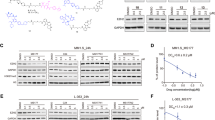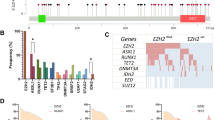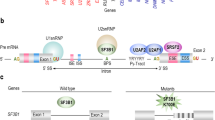Abstract
Both proto-oncogenic and tumor-suppressive functions have been reported for enhancer of zeste homolog 2 (EZH2). To investigate the effects of its inactivation, a mutant EZH2 lacking its catalytic domain was prepared (EZH2-dSET). In a mouse bone marrow transplant model, EZH2-dSET expression in bone marrow cells induced a myelodysplastic syndrome (MDS)-like disease in transplanted mice. Analysis of these mice identified Abcg2 as a direct target of EZH2. Intriguingly, Abcg2 expression alone induced the same disease in the transplanted mice, where stemness genes were enriched. Interestingly, ABCG2 expression is specifically high in MDS patients. The present results indicate that ABCG2 de-repression induced by EZH2 mutations have crucial roles in MDS pathogenesis.
This is a preview of subscription content, access via your institution
Access options
Subscribe to this journal
Receive 12 print issues and online access
$259.00 per year
only $21.58 per issue
Buy this article
- Purchase on Springer Link
- Instant access to full article PDF
Prices may be subject to local taxes which are calculated during checkout






Similar content being viewed by others
References
Nikoloski G, Langemeijer SM, Kuiper RP, Knops R, Massop M, Tonnissen ER et al. Somatic mutations of the histone methyltransferase gene EZH2 in myelodysplastic syndromes. Nat Genet 2010; 42: 665–667.
Makishima H, Jankowska AM, Tiu RV, Szpurka H, Sugimoto Y, Hu Z et al. Novel homo- and hemizygous mutations in EZH2 in myeloid malignancies. Leukemia 2010; 24: 1799–1804.
Patel B, Hirsch C, Clemente M, Sekeres M, Makishima H, Maciejewski JP . Genetic and molecular characterization of myelodysplastic syndromes and related myeloid neoplasms. Int J Hematol 2015; 101: 213–218.
Haferlach T, Nagata Y, Grossmann V, Okuno Y, Bacher U, Nagae G et al. Landscape of genetic lesions in 944 patients with myelodysplastic syndromes. Leukemia 2014; 28: 241–247.
Bejar R, Stevenson K, Abdel-Wahab O, Galili N, Nilsson B, Garcia-Manero G et al. Clinical effect of point mutations in myelodysplastic syndromes. N Engl J Med 2011; 364: 2496–2506.
Devillier R, Mansat-De Mas V, Gelsi-Boyer V, Demur C, Murati A, Corre J et al. Role of ASXL1 and TP53 mutations in the molecular classification and prognosis of acute myeloid leukemias with myelodysplasia-related changes. Oncotarget 2015; 6: 8388–8396.
Ringrose L, Paro R . Epigenetic regulation of cellular memory by the Polycomb and Trithorax group proteins. Ann Rev Genet 2004; 38: 413–443.
Lund K, Adams PD, Copland M . EZH2 in normal and malignant hematopoiesis. Leukemia 2014; 28: 44–49.
Cao R, Wang L, Wang H, Xia L, Erdjument-Bromage H, Tempst P et al. Role of histone H3 lysine 27 methylation in Polycomb-group silencing. Science 2002; 298: 1039–1043.
Takamatsu-Ichihara E, Kitabayashi I . The roles of Polycomb group proteins in hematopoietic stem cells and hematological malignancies. Int J Hematol 2016; 103: 634–642.
Vakoc CR, Mandat SA, Olenchock BA, Blobel GA . Histone H3 lysine 9 methylation and HP1gamma are associated with transcription elongation through mammalian chromatin. Mol Cell 2005; 19: 381–391.
de Napoles M, Mermoud JE, Wakao R, Tang YA, Endoh M, Appanah R et al. Polycomb group proteins Ring1A/B link ubiquitylation of histone H2A to heritable gene silencing and X inactivation. Dev Cell 2004; 7: 663–676.
Wang H, Wang L, Erdjument-Bromage H, Vidal M, Tempst P, Jones RS et al. Role of histone H2A ubiquitination in Polycomb silencing. Nature 2004; 431: 873–878.
Varambally S, Dhanasekaran SM, Zhou M, Barrette TR, Kumar-Sinha C, Sanda MG et al. The polycomb group protein EZH2 is involved in progression of prostate cancer. Nature 2002; 419: 624–629.
Varambally S, Cao Q, Mani RS, Shankar S, Wang X, Ateeq B et al. Genomic loss of microRNA-101 leads to overexpression of histone methyltransferase EZH2 in cancer. Science 2008; 322: 1695–1699.
Morin RD, Johnson NA, Severson TM, Mungall AJ, An J, Goya R et al. Somatic mutations altering EZH2 (Tyr641) in follicular and diffuse large B-cell lymphomas of germinal-center origin. Nat Genet 2010; 42: 181–185.
Ernst T, Chase AJ, Score J, Hidalgo-Curtis CE, Bryant C, Jones AV et al. Inactivating mutations of the histone methyltransferase gene EZH2 in myeloid disorders. Nat Genet 2010; 42: 722–726.
Khan SN, Jankowska AM, Mahfouz R, Dunbar AJ, Sugimoto Y, Hosono N et al. Multiple mechanisms deregulate EZH2 and histone H3 lysine 27 epigenetic changes in myeloid malignancies. Leukemia 2013; 27: 1301–1309.
Sashida G, Harada H, Matsui H, Oshima M, Yui M, Harada Y et al. Ezh2 loss promotes development of myelodysplastic syndrome but attenuates its predisposition to leukaemic transformation. Nat Commun 2014; 5: 4177.
Mochizuki-Kashio M, Mishima Y, Miyagi S, Negishi M, Saraya A, Konuma T et al. Dependency on the polycomb gene Ezh2 distinguishes fetal from adult hematopoietic stem cells. Blood 2011; 118: 6553–6561.
Tanaka S, Miyagi S, Sashida G, Chiba T, Yuan J, Mochizuki-Kashio M et al. Ezh2 augments leukemogenicity by reinforcing differentiation blockage in acute myeloid leukemia. Blood 2012; 120: 1107–1117.
Muto T, Sashida G, Oshima M, Wendt GR, Mochizuki-Kashio M, Nagata Y et al. Concurrent loss of Ezh2 and Tet2 cooperates in the pathogenesis of myelodysplastic disorders. J Exp Med 2013; 210: 2627–2639.
Zhou S, Schuetz JD, Bunting KD, Colapietro AM, Sampath J, Morris JJ et al. The ABC transporter Bcrp1/ABCG2 is expressed in a wide variety of stem cells and is a molecular determinant of the side-population phenotype. Nat Med 2001; 7: 1028–1034.
Scharenberg CW, Harkey MA, Torok-Storb B . The ABCG2 transporter is an efficient Hoechst 33342 efflux pump and is preferentially expressed by immature human hematopoietic progenitors. Blood 2002; 99: 507–512.
Zhou S, Morris JJ, Barnes Y, Lan L, Schuetz JD, Sorrentino BP . Bcrp1 gene expression is required for normal numbers of side population stem cells in mice, and confers relative protection to mitoxantrone in hematopoietic cells in vivo. Proc Natl Acad Sci USA 2002; 99: 12339–12344.
Nakahara F, Sakata-Yanagimoto M, Komeno Y, Kato N, Uchida T, Haraguchi K et al. Hes1 immortalizes committed progenitors and plays a role in blast crisis transition in chronic myelogenous leukemia. Blood 2010; 115: 2872–2881.
Kato N, Kitaura J, Doki N, Komeno Y, Watanabe-Okochi N, Togami K et al. Two types of C/EBPalpha mutations play distinct but collaborative roles in leukemogenesis: lessons from clinical data and BMT models. Blood 2011; 117: 221–233.
Uchida T, Kitaura J, Nakahara F, Togami K, Inoue D, Maehara A et al. Hes1 upregulation contributes to the development of FIP1L1-PDGRA-positive leukemia in blast crisis. Exp Hematol 2014; 42: 369–79.e3.
Togami K, Kitaura J, Uchida T, Inoue D, Nishimura K, Kawabata KC et al. A C-terminal mutant of CCAAT-enhancer-binding protein alpha (C/EBPalpha-Cm) downregulates Csf1r, a potent accelerator in the progression of acute myeloid leukemia with C/EBPalpha-Cm. Exp Hematol 2015; 43: 300–8e1.
Kitamura T, Koshino Y, Shibata F, Oki T, Nakajima H, Nosaka T et al. Retrovirus-mediated gene transfer and expression cloning: powerful tools in functional genomics. Exp Hematol 2003; 31: 1007–1014.
Ichikawa Y . Differentiation of a cell line of myeloid leukemia. J Cell Physiol 1969; 74: 223–234.
Ralph P, Ho MK, Litcofsky PB, Springer TA . Expression and induction in vitro of macrophage differentiation antigens on murine cell lines. J Immunol 1983; 130: 108–114.
Guchhait P, Tosi MF, Smith CW, Chakaraborty A . The murine myeloid cell line 32Dcl3 as a model system for studying neutrophil functions. J Immunol Methods 2003; 283: 195–204.
Fiskus W, Wang Y, Sreekumar A, Buckley KM, Shi H, Jillella A et al. Combined epigenetic therapy with the histone methyltransferase EZH2 inhibitor 3-deazaneplanocin A and the histone deacetylase inhibitor panobinostat against human AML cells. Blood 2009; 114: 2733–2743.
Chen Z, Liu F, Ren Q, Zhao Q, Ren H, Lu S et al. Suppression of ABCG2 inhibits cancer cell proliferation. Int J Cancer 2010; 126: 841–851.
Sukowati CH, Rosso N, Pascut D, Anfuso B, Torre G, Francalanci P et al. Gene and functional up-regulation of the BCRP/ABCG2 transporter in hepatocellular carcinoma. BMC Gastroenterol 2012; 12: 160.
Liu WH, Liu HB, Gao DK, Ge GQ, Zhang P, Sun SR et al. ABCG2 protects kidney side population cells from hypoxia/reoxygenation injury through activation of the MEK/ERK pathway. Cell Transplant 2013; 22: 1859–1868.
Bagger FO, Sasivarevic D, Sohi SH, Laursen LG, Pundhir S, Sonderby CK et al. BloodSpot: a database of gene expression profiles and transcriptional programs for healthy and malignant haematopoiesis. Nucleic Acids Res 2015; 44: D917–D924.
Gollner S, Oellerich T, Agrawal-Singh S, Schenk T, Klein HU, Rohde C et al. Loss of the histone methyltransferase EZH2 induces resistance to multiple drugs in acute myeloid leukemia. Nat Med 2017; 23: 69–78.
Pasini D, Bracken AP, Hansen JB, Capillo M, Helin K . The polycomb group protein Suz12 is required for embryonic stem cell differentiation. Mol Cell Biol 2007; 27: 3769–3779.
Shen X, Liu Y, Hsu YJ, Fujiwara Y, Kim J, Mao X et al. EZH1 mediates methylation on histone H3 lysine 27 and complements EZH2 in maintaining stem cell identity and executing pluripotency. Mol Cell 2008; 32: 491–502.
Doyle LA, Yang W, Abruzzo LV, Krogmann T, Gao Y, Rishi AK et al. A multidrug resistance transporter from human MCF-7 breast cancer cells. Proc Natl Acad Sci USA 1998; 95: 15665–15670.
Ikebuchi Y, Ito K, Takada T, Anzai N, Kanai Y, Suzuki H . Receptor for activated C-kinase 1 regulates the cell surface expression and function of ATP binding cassette G2. Drug Metab Dispos 2010; 38: 2320–2328.
Liang SC, Yang CY, Tseng JY, Wang HL, Tung CY, Liu HW et al. ABCG2 localizes to the nucleus and modulates CDH1 expression in lung cancer cells. Neoplasia 2015; 17: 265–278.
Acknowledgements
We thank Hiroshi Kimura for antibodies for histones, and Goro Sashida and Atsushi Iwama for advice in EZH2 experiments. We also thank Yosuke Ogata for technical assistance in the analysis of clinical specimens. This study was supported by grants in aid from the Ministry of Education, Science, Technology, Sports and Culture, Japan (no. 23249051 and no. 15H04855).
Author contributions
Performed the experiments: KCK, YH, DI, HS, HM, HH and YH; analyzed the data: KCK, YH and YH; contributed reagents/materials/analysis tools: HA, HH and YH; wrote paper: KCK and TK; secured funding: YT, SG and TK; data interpretation: all other authors.
Author information
Authors and Affiliations
Corresponding author
Ethics declarations
Competing interests
The authors declare no conflict of interest.
Additional information
Supplementary Information accompanies this paper on the Leukemia website
Supplementary information
Rights and permissions
About this article
Cite this article
Kawabata, K., Hayashi, Y., Inoue, D. et al. High expression of ABCG2 induced by EZH2 disruption has pivotal roles in MDS pathogenesis. Leukemia 32, 419–428 (2018). https://doi.org/10.1038/leu.2017.227
Received:
Revised:
Accepted:
Published:
Issue Date:
DOI: https://doi.org/10.1038/leu.2017.227
This article is cited by
-
Multidrug efflux transporter ABCG2: expression and regulation
Cellular and Molecular Life Sciences (2021)



